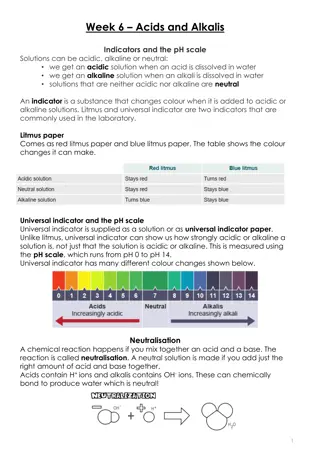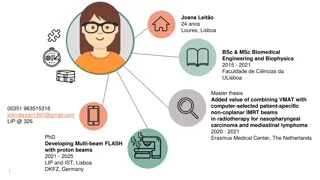Neutralization of Proton Beam Through Charge Exchange Cell
Collisions between neutral particle beams and target materials at varying projectile energies play a crucial role in numerous applications. Charge exchange cells facilitate the generation of high-velocity neutral particles by neutralizing fast ions within a high-density gas region. By capturing electrons from neutral atoms, protons exiting the cell are transformed into fast neutral hydrogen atoms. To ensure a pure neutral beam, charged plates can be employed to deflect any remaining charged particles before reaching the target. The model involves the geometry of the gas cell, including dimensions and gas introduction mechanisms, alongside the use of microchannels and deflecting plates to control gas density and pressure within the system.
Download Presentation

Please find below an Image/Link to download the presentation.
The content on the website is provided AS IS for your information and personal use only. It may not be sold, licensed, or shared on other websites without obtaining consent from the author.If you encounter any issues during the download, it is possible that the publisher has removed the file from their server.
You are allowed to download the files provided on this website for personal or commercial use, subject to the condition that they are used lawfully. All files are the property of their respective owners.
The content on the website is provided AS IS for your information and personal use only. It may not be sold, licensed, or shared on other websites without obtaining consent from the author.
E N D
Presentation Transcript
Neutralization of a Proton Beam Through a Charge Exchange Cell COMSOL
Introduction Collisions of neutral particle beams with target materials at various projectile energies are important in a number of applications ranging from plasma physics to material processing Beams of high-velocity neutral particles can be obtained using charge exchange cells A charge exchange cell is a region of high-density gas placed on the path of an ion beam The region of high gas density creates a medium in which fast ions can be neutralized to generate a beam of neutral particles at the exit of the cell
Introduction The figure shows the concept behind a charge exchange cell Protons are accelerated toward a cell filled with neutral argon When they pass through the charge exchange cell, the protons can capture electrons from the argon atoms and exit the cell as fast neutral hydrogen atoms Since the probability of electron capture is not very high, charged particles are still present in the beam as it exits the cell Schematic of a simplified charge exchange cell neutralization process
Introduction To get a pure neutral beam at the end of the process, charged plates can be used to deflect the charged particles before the beam reaches its target Schematic of a simplified charge exchange cell neutralization process
Model Definition The figure shows the geometry used in the model The gas cell consists of a tube 40 mm in diameter and 100 mm long The tube has end caps with 2 mm diameter apertures along the cylinder axis The argon gas is introduced into the gas cell through a shower head ring located in the center of the cell Geometry 1
Model Definition The microchannels of the shower head charge exchange cell deflecting plates are used to control the neutral gas density in the cell and create a high-pressure region within the main vacuum system of the instrument To model the gas inflow the outgassing wall boundary condition is used The gas cell is mounted in a vacuum T , which is pumped by a turbomolecular pump (pumping speed of 63 L/s) Geometry 1
Model Definition Free Molecular Flow
Model Definition Free Molecular Flow
Model Definition Electrostatics
Model Definition Charged Particle Tracing
Results The electric potential distribution in the region surrounding the two plates is plotted in the figure Electric potential in the vacuum housing
Results The figure shows a surface plot of the pressure in the apparatus Pressure in the apparatus
Results The corresponding number density is computed along the symmetry axis of the cylindrical cell and is plotted in the figure Axial number density through the gas cell and vacuum housing for argon for a constant mass flow rate of 0.05 sccm into the gas cell
Results The particle trajectories are plotted in the figure The color expression in this plot indicates the charge number of the atoms, which decreases from 1 (red) to 0 (blue) for particles that undergo charge exchange reactions in the cell By comparing the number of particles on the plate to the total number of particles in the model, the neutralization efficiency is estimated to be 13.8% Particle trajectories. Ions are shown in red while neutrals are displayed in blue
Results Because the implementation of the charge exchange reactions is stochastic in nature, this value may change slightly when the model is rerun, depending on the seeding of random numbers Particle trajectories. Ions are shown in red while neutrals are displayed in blue























